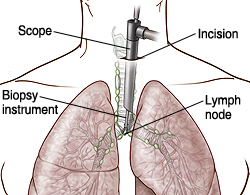Surgery for Lung Cancer
Surgery for Lung Cancer

Mediastinoscopy
A mediastinoscopy might be done to take out a tissue sample. The sample is then used to figure out the extent (stage) of the cancer. During this procedure, the healthcare provider inserts a scope through a small cut (incision) made at the base of the neck. The scope is a long, thin, lighted tube. It is slid into the space between your lungs and behind your breastbone. By looking through the scope, the healthcare provider can see lymph nodes and other tissues in this area. Lymph nodes may be removed so they can be tested for cancer. If no cancer is found in them, you may have more surgery (see below). If cancer has spread to the lymph nodes, more surgery may not be done. This is because the chance of curing it with surgery is low. This decision is based partly on which lymph nodes the cancer has spread to. It's also based on how much of the healthy lung must be taken out to remove all of the cancer.
Surgery
The type of surgical procedure done to treat lung cancer will depend on the location and extent of the cancer. The goal of surgery is to remove visible areas of cancer. This often requires taking out all or part of a lung:
Segmentectomy or wedge resection. This surgery removes the cancerous tissue and a small area of healthy tissue around it.
Lobectomy. This surgery removes an entire lobe of the lung. This is often the preferred type of surgery for lung cancer if it can be done.
Pneumonectomy. This surgery removes the whole lung.

In some cases, a procedure called video-assisted thoracic surgery (VATS) may be a choice. It is typically used only for early stage cancer near the outside of the lung. The lung tissue is removed through several small incisions using special tools and a thin, lighted tube. The tube has a video camera at the end to let the healthcare provider see inside the chest. Less pain, a shorter hospital stay, and quicker healing are benefits of this type of surgery.
Risks and complications
Lung surgery has certain risks and possible complications. These include:
Risks of general anesthesia
Infection
Bleeding
Air leaking through the lung wall
Heart problems
Blood clots in the legs
Shortness of breath (especially in people with other lung problems)
Talk with your healthcare providers about what problems to look for and when to call them. Make sure you know what number to call with questions or problems, including after office hours, on weekends, and on holidays.
Updated:
January 24, 2018
Sources:
Management of stage I and stage II non-small cell lung cancer. UpToDate
Reviewed By:
Gersten, Todd, MD,Stump-Sutliff, Kim, RN, MSN, AOCNS